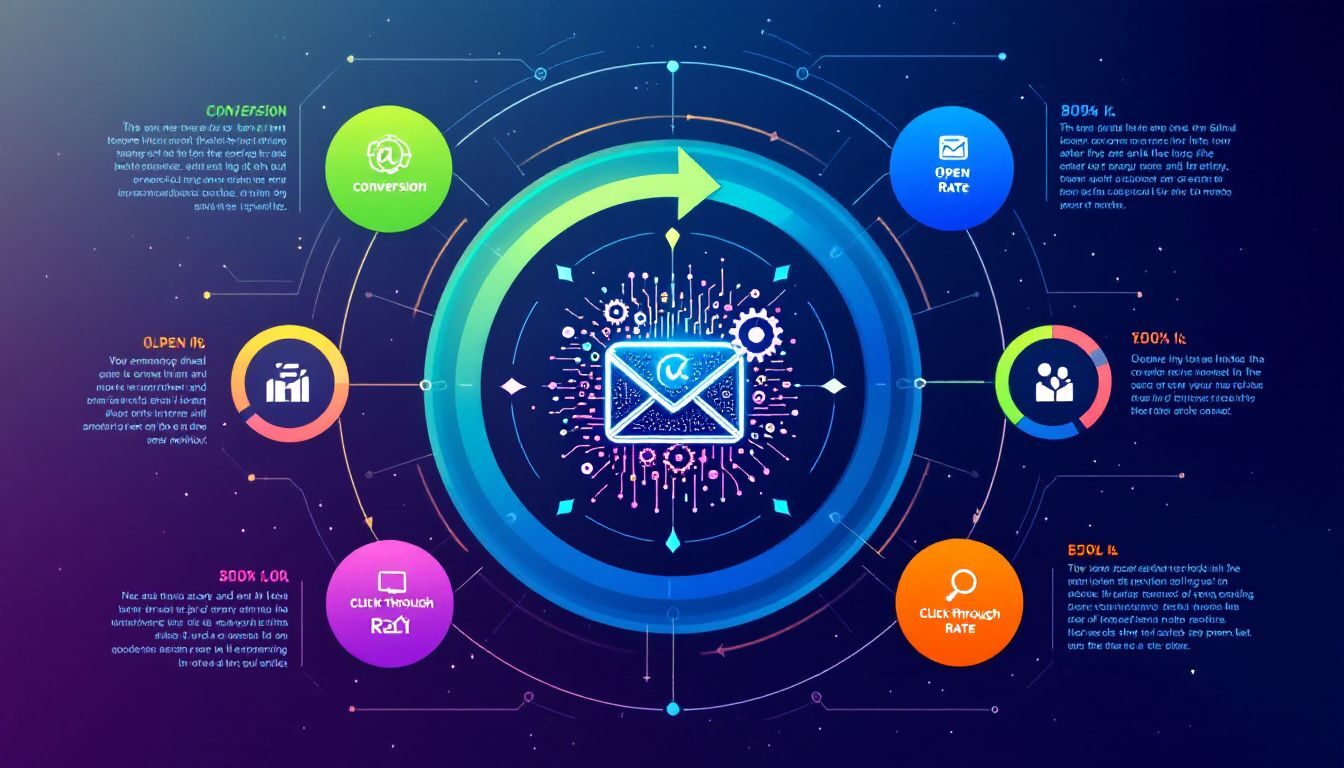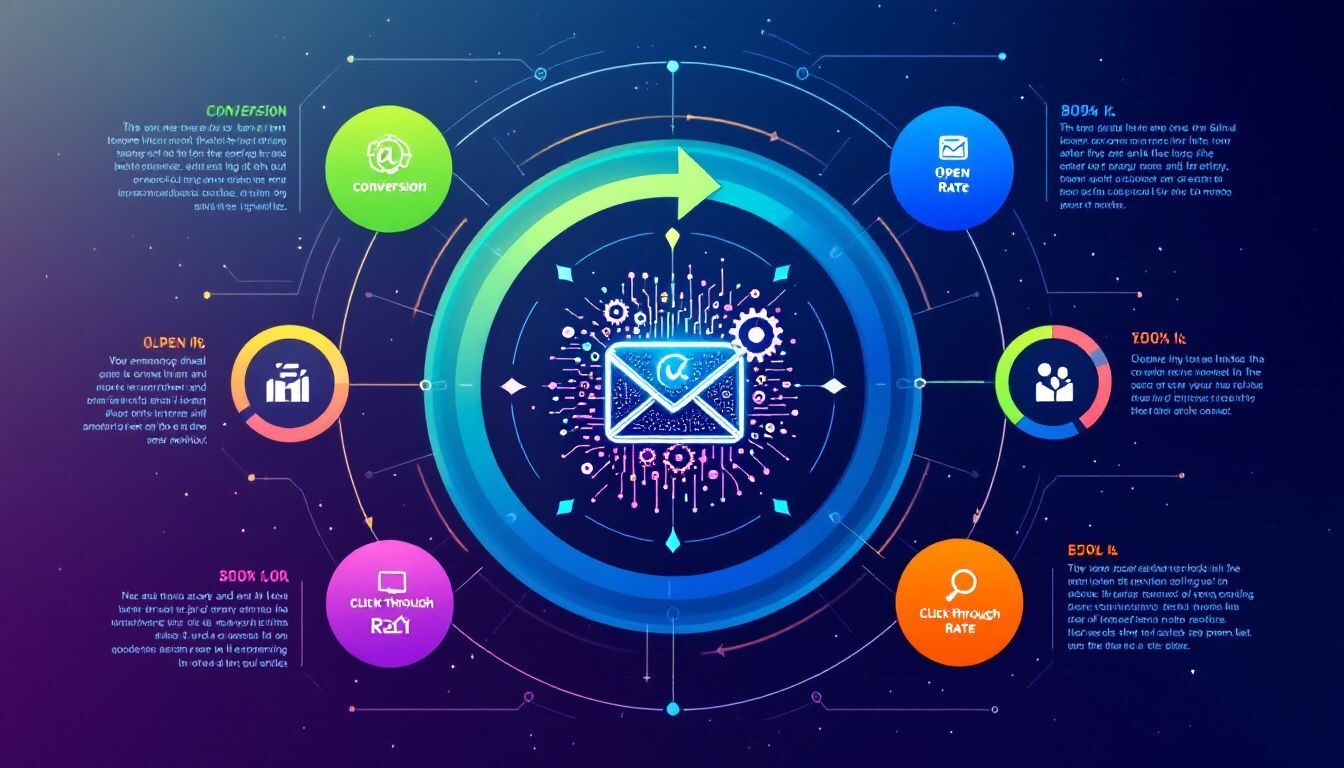
Boost Your Business with Effective Email Marketing ROI Strategies
Email marketing ROI is crucial for evaluating the success of your campaigns. Are your efforts paying off? Understanding this helps you make smarter decisions and boost profitability. In this article, we’ll walk you through practical strategies, from calculating ROI to optimizing your campaigns for better returns. Integrating email into your overall marketing program is essential for enhancing your marketing strategies and outcomes.
Key Takeaways
-
Understanding and measuring email marketing ROI is essential for evaluating campaign effectiveness and making informed marketing decisions.
-
Accurate ROI calculation requires the inclusion of all associated costs and offers insights into which campaigns are delivering the highest returns.
-
Implementing strategies such as personalization, automation, and A/B testing can significantly enhance email marketing performance and profitability.
Understanding Email Marketing ROI

When it comes to digital marketing, businesses often face the challenge of quantifying the exact impact of their email campaigns. This uncertainty can lead to ambiguous ROI assessments, making it difficult to determine the true value of email marketing efforts. However, understanding and accurately measuring email marketing ROI is crucial for evaluating the effectiveness and profitability of your campaigns.
Email marketing ROI refers to the return on investment that businesses achieve from their email marketing efforts. It serves as a universal measure of profitability, helping marketers compare the performance of different campaigns and make informed decisions about resource allocation. Calculating ROI, or investment’s ROI, involves comparing the net income generated from email campaigns to the cost of those campaigns, providing a clear picture of their profitability. This helps businesses pinpoint successful strategies and areas needing improvement, thereby enhancing overall marketing effectiveness.
Assessing email marketing ROI is not just about crunching numbers; it’s about gaining insights into your marketing performance and making data-driven decisions. Understanding key metrics and factors influencing ROI enables businesses to optimize email marketing strategies for higher profitability and sustained growth.
Definition of ROI in Email Marketing
ROI, or Return on Investment, is a fundamental concept in the business world, representing the profitability of an investment after accounting for costs. In the context of email marketing, ROI measures the return on an investment relative to its cost, assessing whether the net returns from a campaign exceed the total costs involved. This helps businesses evaluate the financial success of their email marketing efforts and determine if they are getting a good return on their investment.
Using ROI as a metric allows businesses to compare different email marketing campaigns and other marketing channels. This universal measure of profitability allows marketers to identify which campaigns deliver the highest ROI and which ones need optimization.
Knowing how to calculate and interpret ROI is crucial for maximizing the effectiveness of email marketing strategies.
Importance of Measuring Email Marketing ROI
Measuring ROI is critical for determining the success and profitability of email marketing campaigns. It allows businesses to assess the rates of return on money invested, providing insights into the effectiveness of their marketing efforts. Without measuring ROI, businesses might continue to invest in ineffective campaigns, wasting valuable resources.
Calculating ROI helps businesses determine which activities to fund and which to cut, ensuring efficient resource use and maximizing profitability. Moreover, understanding the ROI of email marketing campaigns helps businesses make strategic decisions, allocate budgets more effectively, and improve overall marketing performance.
Articles focused on best practices in email marketing can further enhance the understanding and effectiveness of ROI measurement.
Email Marketing Effectiveness
Email marketing is 40x more effective at acquiring customers than Facebook or Twitter
Email marketing has proven to be a powerhouse in customer acquisition, boasting a success rate 40 times higher than that of social media platforms like Facebook and Twitter. This remarkable effectiveness stems from the ability of email to deliver personalized and targeted communication directly to potential customers’ inboxes. Unlike social media, where messages can easily get lost in the noise, email marketing allows businesses to craft tailored messages that resonate with individual recipients, significantly increasing the likelihood of conversion.
Moreover, email marketing campaigns offer robust tracking and measurement capabilities. Businesses can monitor open rates, click-through rates, and conversion rates, enabling them to refine their strategies and improve their ROI. This data-driven approach ensures that email marketing remains a highly effective tool for customer acquisition, driving both
59% of people say that email marketing affects purchasing decisions
A significant 59% of consumers report that email marketing influences their purchasing decisions, underscoring the critical role that well-crafted email campaigns play in driving sales. This statistic highlights the power of email marketing to sway consumer behavior and guide them through the purchasing journey.
To leverage this influence, businesses must focus on creating compelling and relevant email content that speaks directly to their target audience’s needs and interests. By doing so, they
How to Calculate Email Marketing ROI

Improving email marketing ROI is essential for business growth and sustainability. To calculate ROI, businesses need to consider both the returns generated from their email campaigns and the total costs associated with them.
This section provides a step-by-step guide on how to calculate email marketing ROI, ensuring that businesses can accurately assess the financial effectiveness of their email marketing strategies. Additionally, ROI is a vital tool for comparing returns from different investments, helping businesses evaluate which investment provides better financial returns.
Basic Formula for Email Marketing ROI Calculation
The basic formula for calculating ROI in email marketing is straightforward: (Net Profit / Total Costs) x 100. To calculate ROI accurately, it’s crucial to consider both the total returns and total costs involved in the marketing campaign.
This formula provides a clear picture of the profitability of your email marketing efforts, allowing you to make informed decisions about future campaigns.
Calculating Net Profit from Email Campaigns
Calculating net income from email campaigns involves determining the total revenue generated and subtracting the associated costs. The components used to determine Net Email Gain include profits from Email Marketing minus Email Marketing Costs. The formula can be summarized as: Net Profit = Total Revenue – Associated Costs. Net profits can be calculated by analyzing the overall performance of the campaigns.
This calculation helps businesses understand the actual financial impact of their email marketing efforts.
Considering All Associated Costs Including Initial Investment
Accurate ROI calculations rely on understanding and incorporating all associated costs, including initial cost. This includes expenses related to software, design, and maintenance, which contribute significantly to the overall expense. Neglecting these costs, often not reflected in conventional financial accounts, can lead to an inflated ROI figure, providing a misleading picture of campaign performance.
It’s essential to consider all costs, such as mortgage interest, property taxes, insurance, and maintenance costs, as they can impact your overall investment cost and ROI calculations. Accounting for all costs provides a more accurate and realistic assessment of email marketing ROI, enabling better investment decisions and improved campaign effectiveness.
Key Factors Influencing Email Marketing ROI

Several key factors influence email marketing ROI, including customer acquisition cost, conversion rates, and customer lifetime value. Understanding these elements can help businesses optimize their email marketing strategies and achieve higher profitability. Additionally, considering net present value (NPV) in ROI calculations is crucial as it accounts for the time value of money by discounting future cash flows to their present value.
Customer Acquisition Cost
Customer acquisition cost refers to the total expense incurred to acquire a new customer, encompassing various marketing and operational expenses. Implementing targeted email campaigns can significantly reduce customer acquisition costs by efficiently nurturing prospects and converting them into customers.
Conversion Rates and Engagement
Conversion rates and customer engagement are critical metrics for measuring the success of email marketing campaigns. Conducting A/B tests can enhance email engagement metrics, with triggered emails seeing double the open and click rates. Focusing on these metrics enables businesses to enhance their email marketing ROI.
Lifetime Value of Customers
Understanding and maximizing the lifetime value of customers is crucial for improving overall ROI. Lowering customer acquisition costs enhances the lifetime value, making each customer more profitable and positively impacting ROI.
Higher engagement rates lead to increased repeat purchases, further enhancing customer lifetime value and ROI.
Strategies to Improve Email Marketing ROI
Optimizing email marketing ROI requires implementing effective strategies. This section explores actionable tactics such as personalization, automation, and A/B testing to enhance email marketing performance and profitability.
Personalization and Segmentation
Personalizing content and segmenting audiences can significantly boost engagement and ROI. Strategies like audience segmentation can help improve engagement and thus enhance ROI.
Small businesses frequently utilize email campaigns to build customer relationships and promote special offers, leading to significant increases in sales.
Automation and Triggered Emails
Automation in email marketing can lead to substantial revenue increases. Automated emails can significantly increase revenue, generating 320% more compared to non-automated emails.
Using automation can enhance the efficiency of email campaigns, allowing timely and relevant communication.
A/B Testing and Optimization
Regular A/B testing can identify the most effective elements in email marketing, leading to improved campaign performance. Continuous A/B testing of email elements helps refine strategies, leading to improved open and click-through rates.
MobileFun utilized A/B testing which resulted in a campaign open rate of 49.17%.
Email Marketing Statistics and Trends
82% of marketers worldwide use email marketing
Email marketing continues to be a cornerstone of successful marketing strategies, with 82% of marketers worldwide incorporating it into their marketing programs. This widespread adoption is a testament to the high return on investment that email marketing offers. Compared to other marketing channels, email marketing consistently delivers impressive results, making it a preferred choice for marketers aiming to maximize their impact.
The enduring popularity of email marketing can be attributed to its ability to reach a broad audience with personalized, targeted messages. As technology evolves and consumer behavior shifts, email marketing remains adaptable, allowing businesses to stay connected with their audience in meaningful ways. With its proven track record of driving engagement and conversions, email marketing is likely to remain
Common Challenges in Email Marketing ROI
Measuring and improving email marketing ROI comes with its own set of challenges. This section identifies common obstacles such as tracking issues and data management, providing insights on how to overcome them.
Tracking and Attribution Issues
Tracking and accurately attributing returns to specific email campaigns is a common challenge. Omitted costs in ROI calculations can inflate the reported figure, misleading marketers about the true performance of their campaigns. Incorporating net present value in ROI calculations is crucial, as it accounts for the time value of money, providing a more accurate assessment of investment performance.
Companies can evaluate the effectiveness of their initial investment by calculating actual ROI versus projected ROI and annualized roi at the end of a set period, as well as considering particular investment returns and investment’s roi.
Data Management and Integration
Managing and integrating data from various sources can complicate ROI measurement. Inconsistent data formats across platforms can hinder the effective tracking of email marketing performance. Businesses need to streamline their data management processes to ensure comprehensive ROI analysis.
Dealing with Low Engagement Rates
Low engagement rates can significantly diminish the effectiveness of email campaigns, ultimately affecting ROI. Implementing strategies to boost engagement, such as personalized content and targeted campaigns, can help address this challenge.
Real-World Examples of High Email Marketing ROI
Showcasing real-world examples of successful email marketing campaigns can provide valuable insights and inspiration. This section highlights success stories from different types of businesses, illustrating the potential for high ROI.
Success Story 1: Retail/Ecommerce
A retail company achieved significant success with its email marketing campaign by implementing targeted email segmentation and appealing designs. Triggered campaigns, although only 2% of total email volume, generated 10% of email-driven revenue, demonstrating their effectiveness. Capital gains from these campaigns significantly contributed to the overall ROI, highlighting the importance of distinguishing between various sources of investment returns.
Success Story 2: B2B Company
A B2B firm increased first-time purchases by tenfold by using AI-driven email copy and customer data to enhance their email marketing strategies. This success story highlights the potential for significant ROI in B2B email marketing.
Success Story 3: Small Business
A small business implemented automated email sequences targeting different customer segments to personalize communication and enhance engagement.
As a result, these initiatives contributed to 29% of its total revenue.
Tools and Resources for Measuring Email Marketing ROI
Having the right tools and resources is essential for accurately measuring and improving email marketing ROI. This section introduces various tools that can help businesses track and enhance their email marketing performance.
Analytics Platforms
Analytics platforms like Google Analytics and Kissmetrics provide detailed insights into the performance of email marketing campaigns. Utilizing these platforms can significantly enhance the understanding and improvement of email marketing ROI.
ROI Calculators
Specialized ROI calculators for email marketing consider various campaign metrics to provide accurate return estimates. These tools can help businesses streamline their ROI calculations by taking into account specific factors such as email open rates, click-through rates, and conversion rates.
ROI calculators provide businesses with a clearer picture of email marketing performance, facilitating data-driven decisions to optimize campaigns through roi calculation.
Educational Resources
There are various educational resources available that can help businesses improve their email marketing ROI. Popular analytics platforms can provide comprehensive insights into email marketing performance, assisting in better ROI measurement. Online ROI calculators specifically designed for email marketing can help businesses streamline their ROI calculations.
Additionally, webinars and online courses offer advanced strategies and insights into optimizing email marketing ROI.
Summary
In conclusion, understanding and optimizing email marketing ROI is essential for any business looking to maximize the effectiveness of its marketing efforts. By accurately calculating ROI, considering all associated costs, and understanding the key factors that influence ROI, businesses can make informed decisions that drive profitability. Implementing strategies such as personalization, automation, and A/B testing can significantly enhance email marketing performance and lead to higher ROI.
Real-world examples of high email marketing ROI demonstrate the potential for businesses of all sizes to achieve impressive returns on their email marketing investments. By utilizing the right tools and resources, businesses can effectively measure and improve their email marketing ROI, ensuring that every dollar invested yields substantial returns. So, take the insights and strategies shared in this blog post and start optimizing your email marketing campaigns for success.
Frequently Asked Questions
What is the return on investment?
Return on investment (ROI) is a measure of an investment’s profitability, calculated by subtracting the initial cost from the final value, dividing by the cost, and multiplying by 100. It quantifies the financial gains relative to the costs of implementing a project or investment.
What is the ROI on direct mail marketing?
The average ROI for direct mail marketing is approximately 30 percent, indicating that for every dollar spent, companies earn an average of 30 cents in profit. This highlights the potential profitability of direct mail campaigns.
Does email marketing have an ROI of 4400%?
Yes, email marketing can indeed have an impressive ROI of 4400%, equating to $44 earned for every dollar spent on campaigns. This demonstrates the effectiveness of email marketing in generating significant returns.
What are some strategies to improve email marketing ROI?
To improve email marketing ROI, implement personalization and segmentation, utilize automation and triggered emails, and engage in regular A/B testing and optimization. These strategies will enhance engagement and ultimately increase revenue.
Want More Email Marketing Tips?
Looking for more in-depth advice on how to grow your list, plan seasonal campaigns, or automate your post-purchase emails? Check out our latest guides and resources to elevate your email marketing game and keep your subscribers excited year-round!
© 2025, Vertical Response. All rights reserved.



